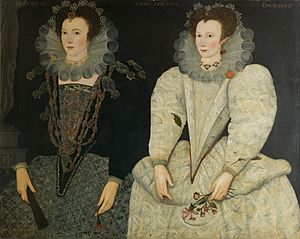Edward Fitton, the younger facts for kids
Sir Edward Fitton the younger (born around 1548, died 1606) was an important Englishman during the time of Queen Elizabeth I. He played a part in the English efforts to settle parts of Ireland with English people, a process known as the plantation of Ireland.
Contents
Sir Edward Fitton's Early Life and Career
Sir Edward Fitton was the son and heir of Sir Edward Fitton (the elder). His family lived in a place called Gawsworth in Cheshire, England. He went to Brasenose College, Oxford, a famous university, and finished his studies in 1566. After that, he studied law at Gray's Inn in 1568.
In 1579, Sir Edward became the Receiver General for Ireland. This meant he was in charge of collecting money for the government there. His father passed away in July of that same year. Sir Edward had hoped to take over his father's job as Vice-Treasurer of Ireland, but he didn't get it. So, he decided to return to England. Before he left, he was made a knight by Sir William Pelham in 1580.
Sir Edward was also involved in English politics. He was chosen to be a Member of Parliament (MP) for Wigan, Lancashire, in 1572. Later, in 1588, he became an MP for Boroughbridge, Yorkshire.
Involvement in the Irish Plantations
Sir Edward became interested in Ireland again when there was a plan to settle the area of Munster with English people. This was part of the Munster Plantation. He was one of the first people to ask for a share of the land that had been taken from the Earl of Desmond.
On September 3, 1587, Sir Edward received official permission for 11,515 acres of land. This land was located in the counties of Limerick, Tipperary, and Waterford in Ireland. However, this land deal did not turn out to be as profitable as he had hoped. On December 19, 1588, he wrote to William Cecil saying he had lost £1,500. He asked if he could be excused from paying rent because of his father's long service and his own.
Sir Edward was very keen on the idea of removing Irish people from the land to make way for English settlers. However, he did not fully meet the requirements of his land grant. He was also known for not living on his Irish land, which was a condition of the grant.
Local Administration and Death
Sir Edward was also active in managing areas near his family home in Gawsworth, Cheshire. From about 1583, he served as a Justice of the Peace (JP) in both Cheshire and Lancashire. A Justice of the Peace helps keep law and order in a local area. In 1591 and 1592, he was the High Sheriff of Lancashire, which is another important local government role. In 1601, he became the mayor of Macclesfield.
Sir Edward Fitton passed away in London in March 1606. He was buried shortly after, on April 3, in Gawsworth.
Sir Edward Fitton's Family
Sir Edward married Alice Holcroft. She was the only daughter and heir of Sir John Holcroft. Alice lived until February 5, 1626. After Sir Edward's death in 1606, she had a monument built in Gawsworth Church to remember him.
Sir Edward and Alice had several children. Their son, also named Sir Edward Fitton (born 1572, died 1619), continued the family line. They also had another son, Alexander, and two daughters, Anne and Mary. Mary Fitton is famous because some people believe she might have been the "Dark Lady" mentioned in Shakespeare's sonnets.
The direct male line of Sir Edward Fitton's family ended in 1643. This led to a long and difficult dispute over who would inherit the family's property, which lasted for many decades.


